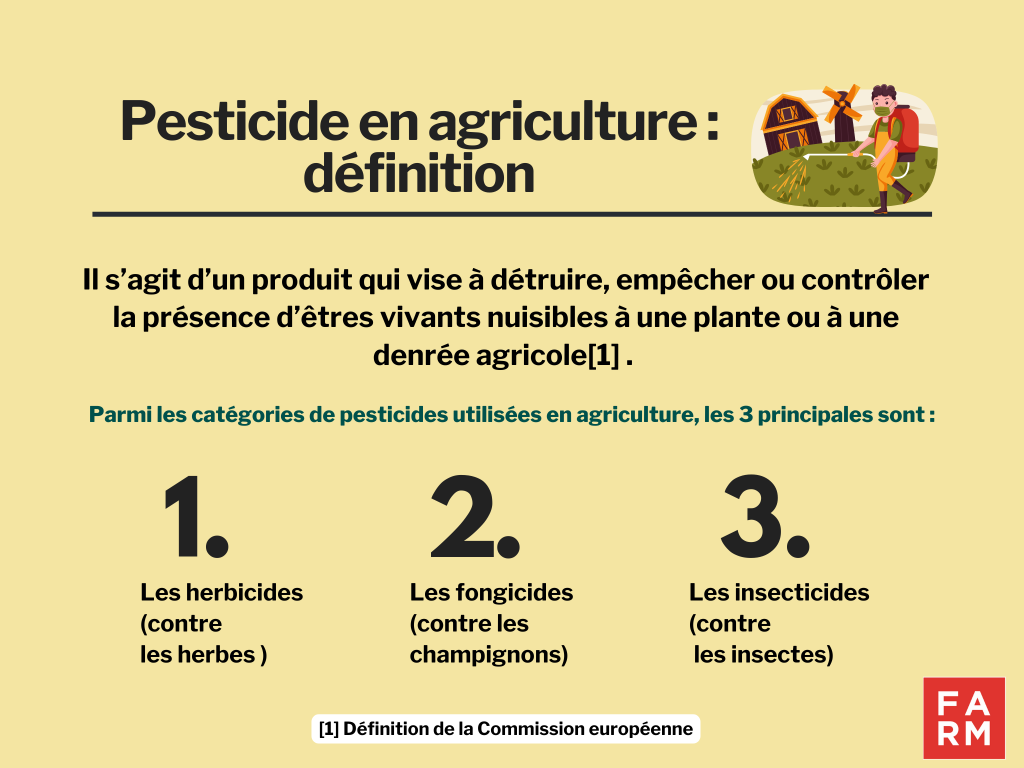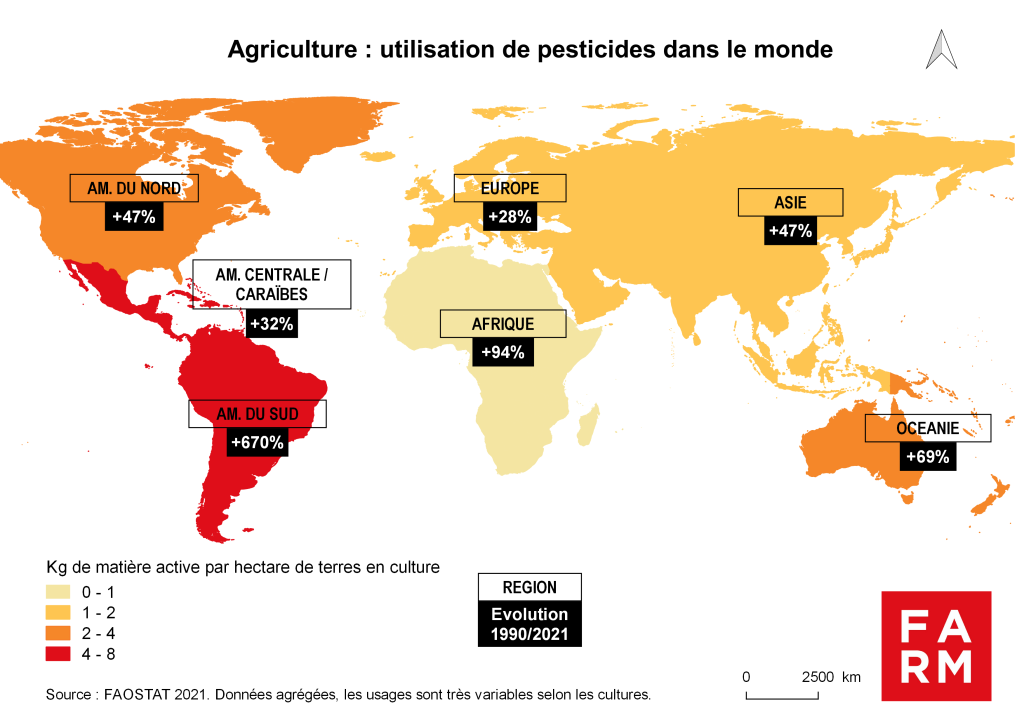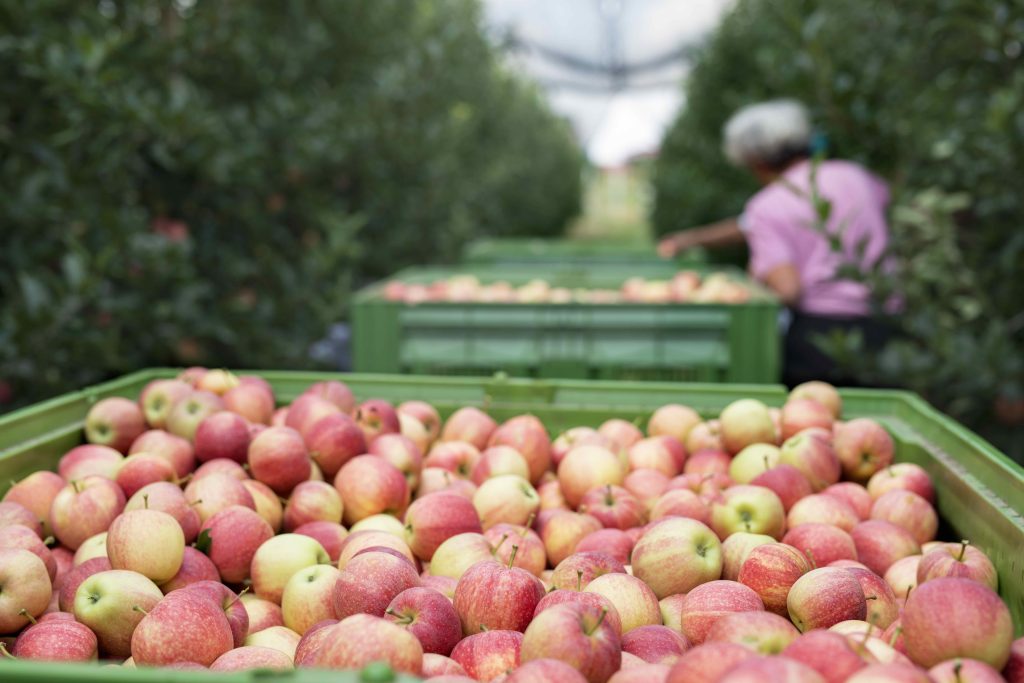Pesticides in agriculture: understanding the issues
The use of pesticides in agriculture represents a major and complex global issue. These substances were designed and deployed to improve crop productivity and health, but their use is increasingly controversial. What pesticides are used in agriculture? What are the consequences of their use? The FARM Foundation offers insights and answers to these questions.

Definition and role of pesticides
The word "pesticide" is a generic term derived from the Latin terms " caedere » (kill) and « pestis » (scourge). It covers various definitions depending on the contexts of use and regulations. For the European Commission[1], in the agricultural sector these are products which aim to destroy, prevent or control the presence of living beings harmful to a plant or agricultural commodity. Their use should improve crop yield and quality by reducing losses caused by harmful organisms. They are also called plant protection products or phytosanitary products.
Pesticides can also be used on products after harvest, to improve the long-term preservation capacity of these products, as is the case, for example, for the storage and transport of cereals.[2].
We can distinguish several categories of pesticides used in agriculture, depending on the different targets. Among the most used, we can cite the herbicides which attack unwanted plants, fungicides to fight against fungi and insecticidesTheir operating principle is based on one or more molecules – the active substances – contained in the product. These act chemically on the metabolism of the pests or plants they target to cause their death. Some substances are very selective, acting only on very specific species or varieties. Others have a broader target spectrum. Glyphosate, for example, is an active substance that kills all plants. This is called a total herbicide.
Active substances can be derived from synthetic chemistry or a natural process. essential oils, for example, fall into the category of biopesticidesThese products are part of a more integrated approach to plant protection that aims to disrupt ecosystems less.[3]. They represent today less than 10 % of the pesticide market.

What is the use of pesticides in agriculture?
The use of active substances in agriculture is not new[4]Farmers have always had to deal with climatic hazards that can encourage disease and weaken plants, or with pests that decimate their crops. FAO estimates that these diseases and pests reduce by 40 % global harvests each year. The use of pesticides has therefore been considered as a means of securing agricultural production, by reducing the risk of significant loss of yield or poor conservation.
Synthetic pesticides became widely used in European and North American agriculture beginning in the second half of the 20th century. Their increasing use went hand in hand with farm specialization, mechanization, the use of chemical fertilizers, and genetic selection, thus forming the technical foundations of the Green Revolution.[5]Easy to access and relatively cheap compared to the productivity gains they brought, they proved effective in participating, alongside other factors such as genetics or irrigation, in increasing yields and their regularity, over large areas.[6]Responding to a growing demand for agricultural products, this model has spread throughout developed countries and to certain developing countries (for example, the cereal sectors in Asia and Latin America and the cotton sector in Sahelian Africa). Today, more than 800 active substances are available on the market and global consumption of pesticides in agriculture exceeds 3 million tonnes per year.[7].
Farmers are now trying to move away from this agricultural model because of its impacts on human health and ecosystems. Producers in organic farming[8] do indeed do without synthetic pesticides. But, they do not necessarily do without pesticides. For example, to fight against certain diseases such as vine mildew or potato, they still remain dependent on the use of copper, excess of which has very harmful effects on soil life[9]Another model occupies significant areas worldwide. : soil conservation agriculture[10]This technique is being developed for large-scale crops in the Americas and Australia, and is also gaining ground in Europe, Asia, and Africa. It involves no longer plowing, covering the soil, and diversifying crops to maintain soil fertility and biodiversity. This concept, which promotes soil function and its biological regulation, effectively reduces dependence on fungicides and insecticides. However, total herbicides, such as glyphosate, are still commonly used to control weeds.
These agriculture that reduces the use of pesticides therefore do not escape the challenges that poses the use of these products.
Uses vary greatly depending on the culture
Pesticide use is linked to crop types and local cultivation practices. Regions where large-scale crops (corn, soybeans, wheat, etc.) predominate, such as the United States, are heavy users of herbicides. Fruit growers use more fungicides such as copper or sulfur.
It should be noted that under certain conditions of use, insects, fungi, or unwanted plants can become resistant to plant protection products. This loss of effectiveness of the molecules leads to a gradual increase in the doses used by farmers and the creation of new pesticides by manufacturers.
Global overview of chemical pesticides
In 2021, global pesticide consumption reached 3.5 million tonnes of active ingredient, or an average of 2.26 kg per hectare of agricultural land. Herbicides are the most widely used category of active substances and represent almost half of this volume.

Pesticide consumption has nearly doubled worldwide since 1990[11]However, this underlying trend masks a very large geographical heterogeneity.Africa uses 11 times less per agricultural hectare than South America and 5 times less than the European Union.[12]. In France, where usage is increasingly regulated, Wheat crops are treated on average 7 times a year, banana plantations in the Antilles 8 times a year and apple orchards receive an average of 36 treatments per year[13]. To explain these significant disparities and their evolution, a quantitative analysis at finer scales (such as that of sectors) would undoubtedly be rich in lessons. But this data is unfortunately still very fragmentary.

The global pesticide market is today dominated by 4 large companies based in Europe and the United States : Syngenta Group, Bayer, Corteva and BASF. In 2018, they controlled approximately 70 % of the global pesticide market[14], whose growth is driven by the development of sales in South America, Southeast Asia and Africa.
What are the consequences of using pesticides?
Producers, agricultural workers and rural populations living in production areas are among those most exposed to pesticides.[15]Frequent handling of chemicals can cause health problems. Health effects can be immediate, such as skin reactions or respiratory problems. Chronic effects, which appear over the longer term, are also observed.[16]Several epidemiological studies conclude that there is a strong presumption of links between exposure to pesticides and the occurrence of cancers or reproductive disorders.[17]This is the case, for example, among agricultural workers on banana farms in the Antilles exposed to chlordecone.[18].
While farmers are the most exposed, pesticides also pose risks to other segments of the population. Toxic molecules are carried by wind and water and generally do not remain where they were applied. By remaining in the environment for many years, they contaminate water and soil.[19] and may end up in the food we consume. Some countries, such as France, are implementing controls on toxic molecule residues in food products. Around 4 % of the checks carried out in 2017 revealed the presence of a molecule banned in France[20]. Such a control system provides a certain level of security for consumers, but it remains limited since only certain known molecules are analyzed. It should be noted that this type of control system remains little used, if at all, in southern countries.
The effects of pesticides on the environment are also being highlighted by civil society and researchers. The molecules eventually degrade, sometimes after several decades, but some residues persist in the environment. The case of chlordecone is instructive.[21]This insecticide was used for about twenty years in banana plantations in Martinique and Guadeloupe. It was banned in 1993 because it was considered dangerous to human health. Its use has led to chronic pollution of soil and water. Thirty years later, the food chain and the local population are still contaminated.
This example illustrates the difficulties faced by public authorities who authorize or prohibit the marketing of these products or regulate their use. It can take a long time to measure chronic impacts on health and the environment. This timescale is difficult to reconcile with the high rate of creation of new chemical pesticides. In addition, regulations on authorizations or uses vary greatly from one country to another. Many active ingredients are banned within the European Union, but it is still possible for European manufacturers to produce and export them to third countries, or to import products containing residues. In the absence of international regulations, national or regional positions are sometimes contradictory, which makes a harmonized and effective approach to regulation difficult.
In conclusion
While pesticides undeniably play a central role in global agriculture, their use is nonetheless a controversial issue. Some argue that they make a vital contribution to global food security, while others see their negative effects on the environment and the health of humans and ecosystems. This market, with significant potential, attracts manufacturers, but scientists and public authorities lack the time and resources to study the risks.
Crop diseases and pests pose a significant threat to the agricultural sector, on which millions of smallholder farmers depend for their incomes and livelihoods, and to global food security. Finding the right balance is a particularly complex challenge on the path to more sustainable agriculture.
In many countries, and particularly in tropical agriculture, there is a lack of knowledge about the uses of pesticides and the institutional and economic frameworks that influence their distribution. Faced with the complexity of this subject, the FARM Foundation and Agropolis Foundation are committed to supporting the production of knowledge and solutions via the Pretag initiative (Pesticide Reduction for Tropical Agricultures), coordinated by the CIRAD.
The ambition of this initiative is to build, with different private and public actors, trajectories for effectively reducing the use of chemical pesticides, relying in particular on multi-actor platforms in the market gardening, rice, coffee, cocoa and banana sectors.
In the coming months, the Foundation will share the progress of this project and offer new publications.
Sources
[2] Control of phytosanitary products (pesticides): treatment of stored foodstuffs (Ministry of Agriculture and Food Sovereignty)) ; France to reverse ban on insecticide to protect grain exports (francetvinfo.fr)
[3] Integrated protection: principles and definitions | Ministry of Agriculture and Food Sovereignty
[4] For example, in ancient Greece, we find traces of the use of sulfur, arsenic, and copper in agriculture – resources present in the natural environment.
[5] Mazoyer and Roudart, 2002, Stories of world agriculture. From the Neolithic to the contemporary crisis.
[6] Over the period 1961-2021, wheat yield in Western Europe increased from 2.6 to 7.0 tonnes per hectare (+169%), and maize yield in the USA from 3.9 to 11.1 tonnes per hectare (+184%) (Source FAO).
[7] FAO data (2019)
[8] According to the FAO, organic farming involves 3 million producers who cultivate 74 million hectares (The World of Organic Agriculture 2021 | FAO) – on 4.7 billion hectares cultivated in the world.
[9] Karimi et al., 2021, Response to comments by Imfeld et al. on the article 'Is soil biodiversity impacted by copper input or accumulation in vineyard soils? Synthesis of scientific knowledge' by Karimi et al.
[10] Conservation agriculture represents 12.5% of global agricultural land, and 68% in South America (Kassam et al., 2022,
Successful Experiences and Lessons from Conservation Agriculture Worldwide)
[13]Agreste surveys on cultural practices in arboriculture in 2018 and in large crops in 2017Between 2012 and 2018, the change in the average number of treatments on apples was not significant; however, the treatment frequency index (TFI – which indicates the number of pesticide doses used per hectare) decreased. For bananas, the average number of treatments decreased but the TFI remained stable. For soft wheat, there was an increase in the average number of treatments and the TFI over the period 2011-2017.
[14] The problem with growing corporate concentration and power in the global food system | Nature Food
[15] Sources of exposure to pesticides – Ministry of Health and Prevention (sante.gouv.fr)
[16] See for example the study by Tiembré et al., 2016. Environmental and health impact of pesticide use in urban and peri-urban market gardening in the Yamoussoukro area, Ivory Coast
[17] INSERM report, 2021, Pesticides and health effects.
[18] INSERM, 2021, p55
[19] Ministry of Ecological Transition, 2020, France's environmental assessment – Pollution of surface and groundwater ; And
Silva et al., 2019, Pesticide residues in European agricultural soils – A hidden reality unfolded.
[20] Control of pesticide residues in plant foods in 2017 | economie.gouv.fr
[21] INSERM, 2021
Un commentaire sur “Les pesticides en agriculture : comprendre les enjeux”
Leave a Reply
You must be logged in to post a comment.

First of all, I would like to commend the quality of this article, which is very well-documented and balanced.
I only regret that the concrete alternatives and technical routes, allowing us to effectively reduce the use of crop protection products, are not described in more detail.
There are many simple, common-sense solutions.
Working for a generic manufacturer of phytosanitary products in Central and West Africa (the region of the world where the quantity consumed per hectare is the lowest), I am also fortunate to work for shareholders who do not impose a volume logic on us. They define our mission in a very simple and non-dogmatic way: to enable small producers to protect their future harvest at an affordable cost (meaning economic, social, health, environmental).
Curiously, the people with whom we have the most difficulty promoting common sense rules (such as the right product in the right dose in the right place at the right time) are the users, and not always the poorest, the youngest or the least educated...
For example, we have been able to demonstrate for more than 10 years (and we are not the only ones) that certain treatments can be spaced out or eliminated, in particular through the use of biostimulants such as mycorrhizae: our biggest detractors are certain research institutes and certain managers of large plantations, who nevertheless have every interest in moving in this direction.
The same people who sometimes recommend using truckloads of mineral oil against banana leaf spot, claiming it's organic.
Your article lays the foundations for a balanced, non-partisan reflection: let us hope that the subject is not hijacked by the most learned, who are not always the most agile and who lead us to believe that the interest of all phytosanitary companies is short-term.
Sincerely
Guy DEBRAY
guy.debray@savana-france.com